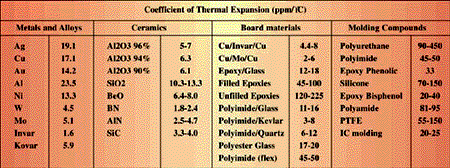This is the second technical data feature that deals with the coefficient of thermal expansion (CTE). The first technical data feature, incorporated in the September 1997 issue, covered semiconductor materials, leadframes and solder alloys. This issue will discuss the temperature dependence of the CTE and present data on other materials that are of importance to electronic parts; molding compounds, ceramics, board materials, metals and alloys.
In principle, thermal expansion is a direct result of the fact that the oscillations of atoms are aharmonic – ie, the movement of atoms in the outward direction from the point of equilibrium is larger than the movement inwards. As a rule of thumb, the coefficient of thermal expansion always increases with temperature because the molecular vibrations increase with temperature and linear relationship exists between the CTE and the thermal capacitance per unit volume. It is well known that the thermal capacitance is only a slight function of the temperature, and so is the CTE. In the operational range of 0-100°C, the maximum deviations are of the order of only 5% for all materials of interest, and thus these deviations can be neglected for most purposes. As the melting point of solids is also strongly related to the strength of the molecular vibrations, it is not surprising that the CTE and the melting point are also related; the higher the melting point, the lower the CTE. This rule can be formulated as follows: the total volume change of most materials between 0°C and their melting point is of the order of 6%. Observe again the rather large discrepancies between various sources of information.






